Valley of Flowers in bloom: A July bucket list hiking adventure in Uttarakhand
Published on July 10, 2025
Valley of flowers tour package, When the monsoon rains start to kiss the Himalayas, a hidden paradise comes alive — the Valley of Flowers. Tucked away in the Garhwal region of Uttarakhand, this UNESCO World Heritage Site transforms into a vibrant canvas of color every July. Thousands of alpine blossoms cover the meadows in waves of pink, purple, red, yellow, and white, making this trek one of the most magical experiences for nature lovers, hikers, and photographers.
At TourMyHoliday, we bring you exclusive Valley Of Flowers Tour Packages to witness this extraordinary natural wonder. Whether you're planning a solo adventure, a couple’s getaway, or a group tour, we offer the most convenient options including Valley of Flowers tour packages from Delhi, Rishikesh, Haridwar, and Mumbai.
What Makes Valley of Flowers So Special?
The Valley of Flowers is not just a pretty place — it’s a rare ecological wonder. Located at an altitude of 3,658 meters in the Chamoli district, the valley stretches over 87.5 square kilometers, blooming with more than 600 species of flowering plants like:
-
Orchids
-
Primulas
-
Poppies
-
Anemones
-
Daisies
-
Himalayan Blue Poppy (rare!)
This vibrant meadow is surrounded by snow-capped peaks and is bordered by rivers and waterfalls. The Valley of Flowers trek is considered an easy to moderate trek, perfect even for beginners with a good fitness level.
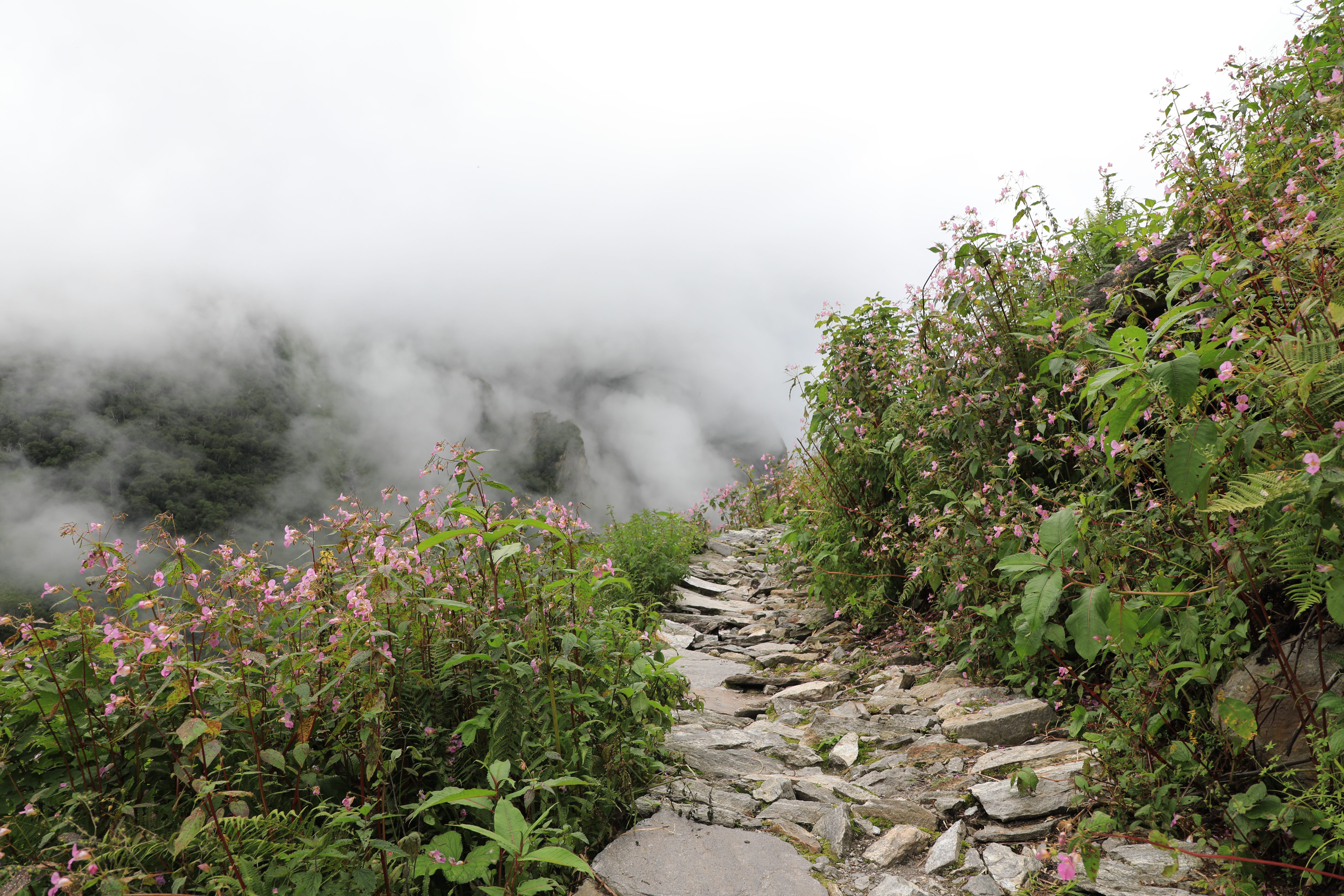
Step-by-Step into Paradise: Your Valley of Flowers Trek Itinerary
Day 1: Arrival in Rishikesh & Drive to Govindghat / Pipalkoti
- Arrive at Rishikesh , the yoga capital of the world, known for its serene vibes and spiritual energy.
- After breakfast, meet your tour representative at The 60s Cafe (The Beatles Café) — a nostalgic start point of your Himalayan journey.
- Begin your scenic drive towards Govindghat / Pipalkoti (approx. 280 km, 8–9 hours), passing through charming hill towns like Vikasnagar, Chinyalisaur, and Joshimath .
- En route, enjoy breathtaking views of snow-capped peaks, deep gorges, and flowing rivers like the Alaknanda and Pindar .
- On reaching Govindghat, check into your pre-booked accommodation.
- Rest and relax for the night, preparing for the trekking days ahead.
Overnight Stay: Govindghat / Pipalkoti
Day 2: Trek from Govindghat / Pipalkoti to Ghangaria (14 km / 7–8 hrs)
- Post an early breakfast, begin your ascent towards Ghangaria , a key base camp for trekkers heading to both the Valley of Flowers and Hemkund Sahib .
- The trail follows the Bhyundar Valley , winding through dense forests of rhododendron and oak, alongside the roaring Pushpawati River .
- Cross several small wooden bridges and witness cascading waterfalls and natural hot springs along the way.
- Reach Ghangaria , a quaint mountain village nestled between two glacial streams, and check into your guesthouse or dormitory.
- Spend the evening exploring the surroundings or relaxing in this tranquil setting.
Overnight Stay: Ghangaria
Day 3: Full-Day Exploration of Valley of Flowers
- Rise early and head out for the much-awaited visit to the Valley of Flowers , located about 3 km from Ghangaria.
- As you enter this UNESCO World Heritage Site, be mesmerized by a vibrant carpet of wildflowers in every shade imaginable — from dazzling reds and purples to soft pinks and yellows.
- Walk through the valley, soaking in the fragrance of alpine flora, and capturing stunning photographs of rare blossoms and butterflies fluttering around.
- Visit the Pushpavati River and enjoy a peaceful sit-down amidst nature.
- Return to Ghangaria in the afternoon for some rest.
- Optional: Visit the nearby Sindhu Ghati Park , another floral attraction slightly off the main trail.
Overnight Stay: Ghangaria
Day 4: Trek to Hemkund Sahib & Back to Ghangaria
- Wake up early and set off for the holy Sri Hemkund Sahib Gurudwara , situated at an altitude of 4,329 meters.
- The trek is steep and moderately challenging (approx. 6 km one-way), passing through rocky terrain and pine forests.
- Upon reaching the gurudwara, experience the spiritual serenity and marvel at the pristine glacial lake beside it.
- Spend time in prayer or simply absorbing the majestic views of surrounding peaks like Mount Nanda Devi .
- Descend back to Ghangaria in the afternoon, where you can unwind and prepare for the return journey.
Overnight Stay: Ghangaria
Day 5: Descent Trek from Ghangaria to Govindghat / Pipalkoti
- Today marks the end of your trekking days. Start your descent back to Govindghat / Pipalkoti .
- The downhill trek (approx. 14 km) is relatively easier and allows you to enjoy the panoramic views without the effort of climbing uphill.
- Take breaks at scenic spots, reflect on your Himalayan journey, and click last-minute pictures.
- On reaching Govindghat, board your waiting vehicle for a relaxing drive back to Rishikesh .
- Overnight halt en route or continue driving depending on time and road conditions.
Overnight Stay: On the way or reach Rishikesh late night (depends on traffic)
Day 6: Transfer to Rishikesh & Departure
- After a refreshing night’s sleep, proceed towards Rishikesh , concluding your soul-stirring Himalayan adventure.
- On arrival in Rishikesh, you may choose to explore local attractions like Lakshman Jhula , Triveni Ghat , or enjoy a peaceful session of meditation or yoga.
- Later, transfer to your onward destination — whether it’s the airport, railway station, or bus stand.
End of Tour
Best Time to Visit: Why July?
The valley starts blooming in late June but July is when the floral magic reaches its peak. The monsoon rains help the flowers blossom in full glory. By the end of July and early August, the landscape becomes so colorful that it feels like walking inside a painter’s dream.
TourMyHoliday offers Valley of Flowers fixed departures throughout July and August, so you can experience the best of this short blooming season.
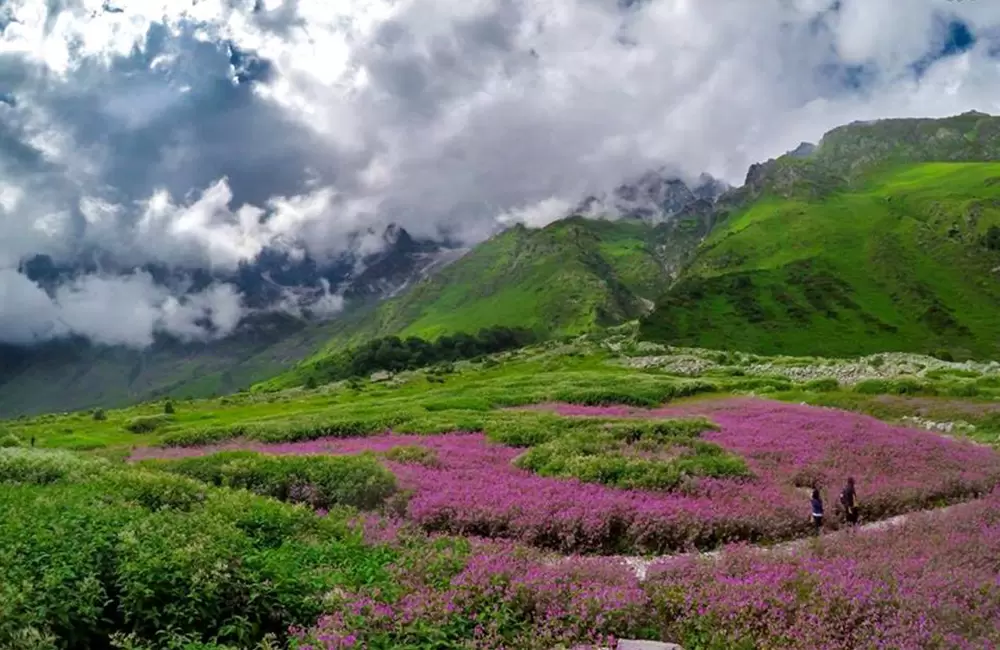
A Glimpse into the Wildlife
Besides the floral spectacle, the Valley of Flowers National Park is also home to rare and endangered wildlife, such as:
-
Himalayan Black Bear
-
Snow Leopard (elusive but spotted!)
-
Musk Deer
-
Blue Sheep
-
Red Fox
-
Himalayan Monal (state bird of Uttarakhand)
If you’re lucky, you might spot these incredible animals while hiking. That’s why many travelers prefer our Valley of Flowers guided tours, where experienced naturalists and locals accompany you on the trek.
Valley of Flowers Tour Package for Couple
Looking for a romantic escape in nature? Our Valley of Flowers tour package for couples is designed for privacy, comfort, and beauty. Imagine walking hand-in-hand among thousands of wildflowers, with misty mountains and cascading waterfalls in the background.
Couple packages include:
-
Cozy stays in private rooms
-
Candlelight dinners in Ghangaria
-
Trek guide and porter services
-
Photographer on request
-
Romantic setup in tents or homestays
It’s perfect for honeymooners or anniversary trips!
Tour Packages from Major Cities
TourMyHoliday offers personalized and group tour options with fixed departures and flexible itineraries from all major cities:
✅ Valley of Flowers Tour Package from Delhi
Includes overnight Volvo or private transport, stays, meals, and complete trekking support. Ideal for groups and solo travelers.
✅ Valley of Flowers Tour Package from Rishikesh
Short and scenic – perfect for spiritual trekkers and yoga enthusiasts visiting Rishikesh.
✅ Valley of Flowers Tour Package from Mumbai
We arrange train/flight connections to Haridwar, then continue the journey with our team. Best for those seeking an extended holiday in the mountains.
.webp)
Inclusions:
-
Pickup & drop (Delhi/Rishikesh/Haridwar)
-
Hotel/accommodation in Joshimath & Ghangaria
-
Vegetarian meals (breakfast, lunch, dinner)
-
Trekking permits & entry fees
-
Local guide for the Valley of Flowers
-
First aid and basic safety gear
Exclusions:
-
Personal expenses (shopping, extra meals, snacks)
-
Pony/helicopter charges (optional)
-
Insurance
-
Tips & donations
What to Pack for the Valley of Flowers Trek
Packing smart is essential for a safe and fun trek.
Essentials:
-
Waterproof trekking shoes
-
Raincoat / Poncho
-
Warm fleece and jacket
-
Sunscreen and sunglasses
-
Trekking pole
-
Reusable water bottle
-
Power bank and camera
Skip:
-
Heavy gadgets
-
Expensive jewelry
-
Bulky luggage
Why Choose TourMyHoliday?
We’re not just another travel agency. At TourMyHoliday, we combine local expertise with personalized care. Here's what makes us the best for your Valley of Flowers trek package:
-
✅ Handpicked guides & accommodations
-
✅ Transparent pricing with no hidden charges
-
✅ Flexible itineraries
-
✅ 24/7 on-trip support
-
✅ Custom couple & family options
-
✅ Fixed group departures in July & August

Must-See Spots on the Trek
Here are a few special highlights included in our Valley of Flowers guided tours:
➤ Pushpawati River
This glacial river runs through the valley and adds charm to the already dreamy landscapes.
➤ Tipra Glacier
Visible from parts of the trail, this majestic glacier reminds you how close you are to the mighty Himalayas.
➤ Hemkund Sahib
Even if you’re not religious, this alpine lake next to a gurudwara is a peaceful and spiritual experience.
The Luxuriant Flora of Valley of Flowers: A Botanical Paradise in the Himalayas
Experience Himalayan Blooming Magic with TourMyHoliday
Hidden in the high altitudes of the Himalayas, where clouds brush the mountains and rivers sing their song, lies a colorful carpet of nature's most precious gift — the Valley of Flowers. Famous for its lush alpine meadows, exotic plants, and unmatched biodiversity, this valley is a dream destination for botanists, nature lovers, and trekkers alike.
Every year, thousands of travelers choose a Valley Of Flowers Tour Package with Tour My Holiday to witness this Himalayan wonderland. From Valley of Flowers tour packages from Delhi to custom-made Valley of Flowers tour packages for couples, this destination promises an unforgettable experience.
But what truly makes the Valley of Flowers special is its rich flora, many of which are rare, endangered, or even found only in this region. Let’s take a closer look at the magnificent flowers that make this valley a living masterpiece.
A Protected Natural Heritage
The Valley of Flowers National Park is a part of the Nanda Devi Biosphere Reserve, and also a UNESCO World Heritage Site. It stretches across 87.5 square kilometers and sits at an altitude between 3,200 to 3,600 meters. This remote area remains untouched by commercial tourism, which helps preserve its fragile floral diversity.
The valley's unique climate, with its cool temperatures, heavy monsoon rains, and snow-fed streams, creates the perfect conditions for over 600 species of flowering plants to thrive here.
With our specially designed Valley of Flowers trek packages, you can walk through this magical floral landscape, guided by experts who help you identify these botanical treasures.
The Most Notable Flowers of Valley of Flowers
Here are some of the most enchanting and rare flowers that you might witness on your trip to the Valley of Flowers:
1. Blue Poppy (Meconopsis aculeata)
A true star of the valley, this sky-blue flower grows in the higher altitudes and is known for its beauty and medicinal value. It’s difficult to spot and blooms for a short period, making it a prized sight for trekkers.
Best spotted: July and early August
Fun fact: It's also known as the Himalayan Blue Poppy.
2. Aconitum Violaceum & Aconitum Balfourii
These are beautiful yet poisonous flowers with purple and blue hues. Their roots are used in traditional Himalayan medicine in minute quantities.
Caution: These plants are toxic and should not be touched.
Fun fact: Used in Ayurveda, but only by trained herbalists.
3. Himalayan Slipper Orchid
One of the most unique orchids, this delicate flower has a slipper-like shape and grows under shaded and damp conditions.
Significance: Rare and protected under forest laws.
Photo tip: Found near the shadowy forested patches on the trail.
4. Geranium Robertianum
This bright pink wildflower adds a splash of color along the valley floor. It is used in herbal teas and traditional medicine.
Medicinal Use: Acts as a mild astringent.
Local name: Herb Robert
5. Brahma Kamal (Saussurea obvallata)
Though not directly in the main Valley of Flowers meadow, this sacred flower is often seen en route to Hemkund Sahib. It blooms only at night and wilts by morning.
Spiritual Value: Considered sacred in Hinduism, offered in temples.
Altitude: 4,000 meters and above
Why Is Valley of Flowers So Botanically Rich?
Several reasons make the Valley of Flowers a botanical hotspot:
-
High Altitude: The valley is located at elevations above 3000 meters.
-
Monsoon-fed Soil: Regular rainfall during July and August helps flower growth.
-
Temperature Variation: Day and night temperature difference supports hardy species.
-
Glacial Rivers: Glacial melt provides mineral-rich water, ideal for rare flora.
This unique combination of factors allows flowers that don’t grow elsewhere in India to flourish here.
Tips for Flower Lovers & Photographers
-
Carry a macro lens or mobile zoom lens for flower close-ups.
-
Visit between July 10 – August 15 for peak bloom.
-
Start your trek early morning to avoid clouds/fog.
-
Follow the marked trail — do not step into flower beds.
-
Respect local rules — no plucking or disturbing plants.
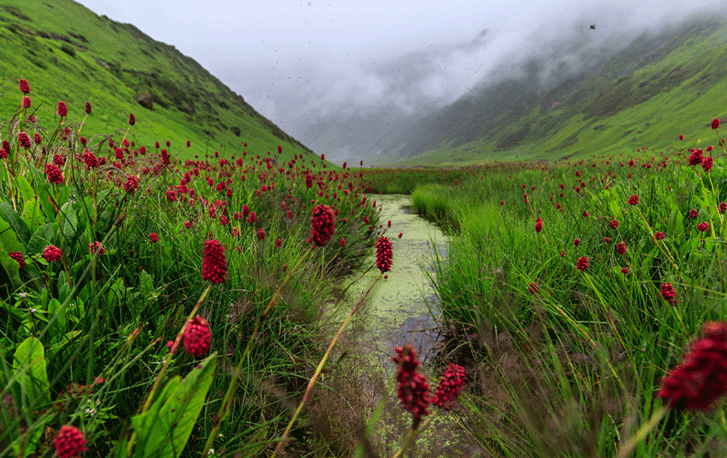
The Hidden Wild: Exploring the Rich Fauna of Valley of Flowers
A Wildlife Lover's Trekking Paradise with TourMyHoliday
While the Valley of Flowers is world-famous for its colorful meadows and vibrant alpine blossoms, there’s another side of this Himalayan wonderland that remains lesser-known but equally fascinating — its diverse and elusive wildlife. Hidden behind misty trails and high ridges, the Valley of Flowers National Park is home to some of the rarest and most majestic animals of the Himalayas.
With TourMyHoliday Valley of Flowers trek packages, travelers get more than just a flower-viewing experience — they enter an untouched ecosystem where nature lives wild and free, where the flutter of a bird or the sudden glimpse of a deer reminds you that you're walking through a protected wildlife sanctuary.
Whether you’re taking a Valley of Flowers tour package from Delhi, Rishikesh, Haridwar, or even Mumbai — keep your eyes open and your camera ready. You may be lucky enough to spot some of these incredible creatures!
A Wildlife Sanctuary in Disguise
Nestled at an altitude between 3,200 and 6,675 meters, the Valley of Flowers National Park is part of the larger Nanda Devi Biosphere Reserve — a UNESCO World Heritage Site. While it is globally recognized for its colorful flora, its fauna diversity is just as exceptional, thanks to the isolated terrain, changing altitudes, thick forests, and snow-fed rivers.
The park supports a wide range of high-altitude mammals, rare birds, and even some endangered species that are difficult to find elsewhere. Our Valley of Flowers guided tours often focus not just on the plant life, but also on faunal tracking, making it a perfect adventure for wildlife enthusiasts and birdwatchers.
Majestic Mammals of the Valley
Here are some of the incredible mammals you might encounter while on a Valley of Flowers trek package:
1. Asiatic Black Bear (Ursus thibetanus)
This powerful creature is recognizable by the white crescent mark on its chest. Mostly nocturnal and shy, the Asiatic black bear prefers dense forested areas near the base of the valley. Sightings are rare, but fresh tracks are often found on guided tours.
Status: Vulnerable
Behavior: Solitary and omnivorous
Best chance to spot: Dawn and dusk, near shaded wooded regions
2. Snow Leopard (Panthera uncia)
The true ghost of the Himalayas. Snow leopards are the most elusive and endangered big cats of this region. They are rarely seen by trekkers but play a critical role in the park’s ecosystem.
Status: Endangered
Habitat: Upper ridges and rocky slopes above 4,000 meters
Interesting fact: Their thick tails help them balance and keep warm
3. Musk Deer (Moschus chrysogaster)
These small, shy deer are known for the musk gland found in males, which has been used in perfumes and traditional medicine. Because of this, they have been heavily hunted in the past.
Status: Endangered
Features: Fanged upper teeth, strong hind legs
Where to spot: Near forest edges and alpine pastures
4. Himalayan Brown Bear
Heavier and more aggressive than the black bear, the brown bear roams the upper regions of the valley. They are more commonly found in the Nanda Devi area but sometimes venture near the valley.
Status: Critically endangered in India
Diet: Omnivorous
Warning: Do not trek alone or too late — always go with guides
5. Red Fox
Sleek, intelligent, and cunning, the Himalayan red fox is often spotted in the early mornings near Ghangaria and forest edges. Its reddish-brown coat and bushy tail make it easy to identify.
Status: Least Concern
Fun Fact: They are known to scavenge near campsites but are generally harmless
6. Blue Sheep (Bharal)
Despite the name, these are more goat than sheep, and are agile climbers found grazing on rocky slopes. They are a major prey for snow leopards and a common sight for early risers.
Status: Near Threatened
Color: Slate-blue body with white underparts
Spotting tip: Look above tree lines on open ridges

Birds of the High Himalayas
The Valley of Flowers isn’t just for mammal-lovers. If you’re into birdwatching, you’re in for a treat! Our Valley of Flowers fixed departures in July and August are ideal for witnessing a range of high-altitude birds.
1. Himalayan Monal (Lophophorus impejanus)
The state bird of Uttarakhand and one of the most strikingly colorful pheasants in the world. Males have a rainbow of colors, while females are more camouflaged.
Where to see: Forested slopes early in the morning
Behavior: Forages in groups, especially near meadows
2. Snow Partridge
A ground-dwelling bird that lives at higher elevations, often seen in pairs or small groups. They are quiet and blend into their environment.
3. Yellow-Billed and Red-Billed Choughs
These birds often accompany trekkers, flying overhead in playful flocks and gliding through valleys.
Fun Tip: Don’t be surprised if they follow your trail — they’re curious!
4. Himalayan Griffon Vulture
One of the largest birds in the region, the Himalayan Griffon circles overhead, looking for carrion. A majestic sight for photographers and birders alike.
Why Is Wildlife So Rich Here?
Several factors make the Valley of Flowers National Park a sanctuary for rich fauna:
-
Isolation: Its remote location reduces human disturbance.
-
Altitudinal Diversity: Ranges from 3,000 to 6,000+ meters, supporting varied habitats.
-
Protected Area: Strict forest and wildlife regulations ensure minimal interference.
-
Natural Food Sources: Plenty of herbs, plants, and small mammals for carnivores and omnivores.
All these make the park a true Himalayan wilderness — and our Valley of Flowers guided tours ensure you experience it respectfully and safely.
Wildlife Tips for Trekkers
Planning your trip with TourMyHoliday? Here are some tips to increase your chances of spotting wildlife:
-
Start Early: Wildlife is most active during early morning hours
-
Stay Quiet: Avoid loud conversations on trails
-
Bring Binoculars: Spot birds and animals from afar
-
Wear Neutral Colors: Helps you blend into the environment
-
Go With Guides: Our Valley of Flowers guided tours improve your chances of sightings safely
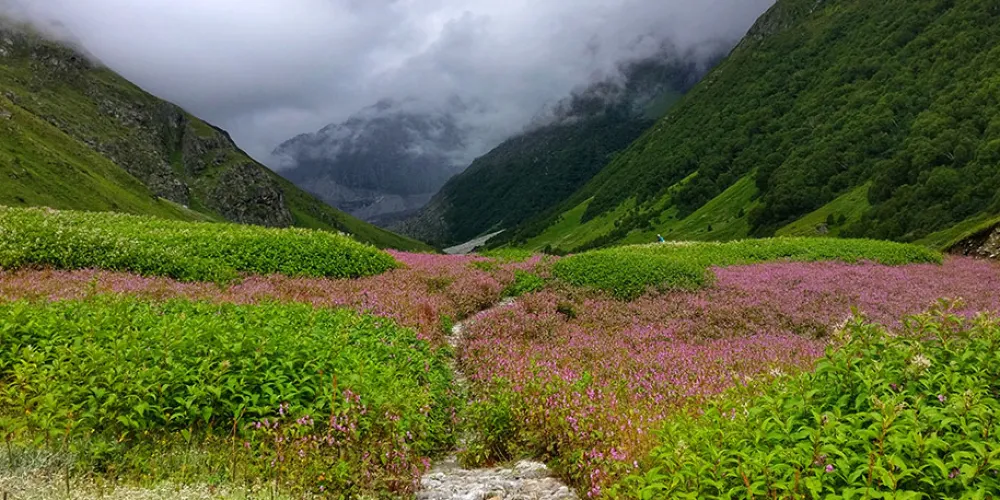
How to Reach the Valley of Flowers: A Complete Travel Guide
Plan Your Journey with TourMyHoliday Expert Trek Packages
The Valley of Flowers in Uttarakhand is a world-famous trekking destination known for its alpine blooms and serene Himalayan landscapes. Nestled high in the Chamoli district, the valley remains untouched by vehicles, which adds to its pristine charm. To witness this natural wonder, you must first reach Govindghat, the last motorable point, and then begin a scenic trek toward Ghangaria and the valley beyond.
At TourMyHoliday, we ensure that your journey is well-planned, smooth, and memorable with our specially curated Valley Of Flowers Tour Packages, which include transportation, lodging, and guided treks from major cities like Delhi, Rishikesh, Haridwar, and Mumbai.
Step-by-Step: How to Reach Valley of Flowers
1. Reaching Govindghat — The Base Point
Govindghat is the starting point for the Valley of Flowers trek. This small town lies on the banks of the Alaknanda River and is located on the NH58 highway, connecting Badrinath and Joshimath.
To get to Govindghat, you can travel from:
By Air:
-
Nearest Airport: Jolly Grant Airport, Dehradun
-
Distance to Govindghat: Approx. 292 km
-
From the airport, you can hire a taxi or take a shared cab/bus to Govindghat via Rishikesh, Srinagar, and Joshimath.
By Train:
-
Nearest Railway Station: Rishikesh Railway Station
-
Distance to Govindghat: Approx. 273 km
-
From Rishikesh, multiple taxis and buses are available to reach Govindghat. The route is scenic, passing through Devprayag, Rudraprayag, and Chamoli.
By Road:
Govindghat is well connected by road to major towns like Rishikesh, Haridwar, and Dehradun. You can drive or book a cab. Buses (private and government) also ply regularly, especially during the trekking season from June to September.
TourMyHoliday offers:
-
Private AC vehicles
-
Shared cabs for groups
-
Bus bookings from Delhi/Rishikesh/Haridwar
All included in your Valley of Flowers tour package from Delhi, Rishikesh, Haridwar, or Mumbai.
2. Govindghat to Ghangaria – The Scenic Trek Begins
Once you arrive at Govindghat, your road journey ends. From here, the real adventure starts.
-
Trek Distance: Approx. 13 km
-
Trek Duration: 6–8 hours depending on pace
-
Mode: On foot, mule, or doli (palanquin)
-
Route: Govindghat ➝ Pulna ➝ Bhyundar ➝ Ghangaria
Pulna is the actual starting point of the trek, about 4 km from Govindghat, and can be reached by a short cab ride. The trail runs along the Pushpawati River, with forests, bridges, waterfalls, and beautiful mountain views along the way.
TourMyHoliday Valley of Flowers trek packages include porters, mules, or even helicopter services (subject to weather and availability) for the trek.
3. Stay at Ghangaria – The Base Camp
Ghangaria is a small village and the base for both the Valley of Flowers and Hemkund Sahib treks. It has accommodation options ranging from budget guesthouses to deluxe stays.
Altitude: 3,050 meters
Facilities: Lodges, tented camps, restaurants, basic medical support
No network zone: Mobile signals are weak or unavailable, ideal for digital detox!
Your Valley of Flowers tour package for couple or group with TourMyHoliday includes comfortable lodging in Ghangaria and all necessary permits for the next leg of your trek.
4. Ghangaria to Valley of Flowers – Final Stretch
This is the most exciting and beautiful part of the journey.
-
Trek Distance: Approx. 3–4 km (one way)
-
Difficulty Level: Easy to moderate
-
Duration: 3–4 hours round trip (or more if you want to explore deeper areas)
The Valley of Flowers opens up like a breathtaking natural amphitheater filled with over 600 species of wildflowers, snow-clad peaks, glacial streams, and rare butterflies.
There are no roads, shops, or buildings inside — just nature in its purest form.
TourMyHoliday Valley of Flowers guided tours ensure you explore the best trails, spot rare flowers and birds, and stay safe while trekking in this protected area.
Why Choose TourMyHoliday for Your Journey?
Whether you’re traveling from Delhi, Rishikesh, Haridwar, or Mumbai, Tour My Holiday makes your entire journey seamless and enjoyable.
Our Tour Options Include:
-
Valley of Flowers tour package from Delhi – With overnight travel and full trek assistance
-
Valley of Flowers tour package from Rishikesh – Ideal for those already in Uttarakhand
-
Valley of Flowers package from Haridwar – A spiritual and scenic start to your trip
-
Valley of Flowers tour package from Mumbai – With train/flight assistance to Dehradun/Haridwar, and full ground transport
-
Valley of Flowers tour package for couple – Romantic treks, cozy stays, and guided exploration
-
Valley of Flowers fixed departures – Join a group for a budget-friendly trek
-
Valley of Flowers guided tours – With experienced local experts who ensure a safe and enriching trek
Important Travel Tips
-
Best Time to Visit: Mid-July to mid-August for peak bloom
-
Fitness: Moderate fitness is required for the trek
-
Weather: Pack for cold and rain – carry raincoats, warm clothes, and sturdy trekking shoes
-
Permits: Required to enter the Valley – included in all our tour packages
-
No Vehicles Beyond Govindghat: Trekking is the only way to access the Valley of Flowers
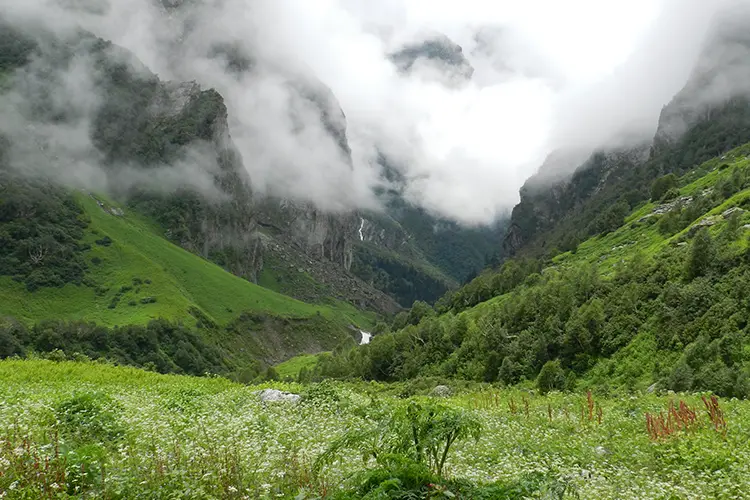
Valley of Flowers Entry Fee 2025: What You Need to Know Before You Go
Plan Ahead with TourMyHoliday for a Smooth Entry Experience
The Valley of Flowers National Park, a UNESCO World Heritage Site tucked in the Garhwal Himalayas, is one of India’s most mesmerizing trekking destinations. But before you lace up your trekking boots and set foot on its blooming trails, it’s important to know the entry guidelines, permit rules, and fee structure — all of which ensure conservation and responsible tourism in this fragile ecosystem.
At TourMyHoliday, we help you navigate these requirements with ease. Whether you're traveling solo, in a group, or on a Valley of Flowers tour package for couple, we handle your permits, entry passes, and other formalities so you can focus on the experience.
Here’s everything you need to know about the Valley of Flowers entry fee in 2025.
Camera Charges and Filming Fees
Bringing a camera to capture the magical meadows? You’re welcome to! But here’s a breakdown of camera-related charges:
-
Still Camera (Personal Use): No extra charge
-
Professional Videography/Filming: Requires special permits and additional charges
-
Drone Use & Commercial Shoots: Strictly regulated and charged as per forest department norms
TourMyHoliday assists in securing required permissions if you're planning to shoot professionally. Just let us know at the time of booking your Valley of Flowers trek package.
Permit and ID Requirements
To preserve the ecological integrity of the Valley, all visitors must carry valid permits and government-approved ID.
✅ Mandatory Documents:
-
Aadhar Card / Voter ID / Passport (for Indians)
-
Passport & Visa (for foreign nationals)
-
Student ID (if applying for discounted student entry)
✅ How to Get a Permit:
-
Permits can be booked online in advance
-
Or arranged via authorized operators like TourMyHoliday as part of your package
-
Same-day permits may be unavailable during peak season, so book early!
How Long Is the Entry Valid?
The standard entry pass is valid for 3 consecutive days from the date of first entry. If you're planning multiple visits (e.g., rest day in Ghangaria), this flexibility is ideal.
Need to extend your trek or re-enter after 3 days? You’ll need to purchase a fresh permit at the forest office in Ghangaria.
Group Bookings and Discounts
Planning a group adventure with friends or colleagues? Our Valley of Flowers fixed departures offer discounted group rates and include permit fees in your package cost.
Students and youth groups also enjoy special attention, with student-discounted entry available through verified documents.
How TourMyHoliday Makes Entry Easy
With our all-inclusive Valley Of Flowers Tour Packages — from Delhi, Rishikesh, Haridwar, or even Mumbai — we make sure your entry to the park is hassle-free.
What’s included in our entry assistance:
-
✔️ Online permit registration
-
✔️ ID verification support
-
✔️ Group or couple pass arrangements
-
✔️ Photography permits (if needed)
-
✔️ Student and senior discounts pre-applied
-
✔️ On-ground team at Ghangaria for coordination
Whether you’re trekking solo, joining our fixed departure, or booking a Valley of Flowers tour package for couple, we’ve got your entry covered.
Final Reminders
-
Entry Timings: The Valley is open sunrise to sunset; no overnight stays allowed inside the park.
-
Eco-Protection: No littering, flower-picking, or wildlife disturbance allowed.
-
Guides Recommended: Our Valley of Flowers guided tours enhance your experience with knowledge about the flora and fauna.
-
Only Trek Access: No vehicles allowed beyond Govindghat — trek is mandatory.
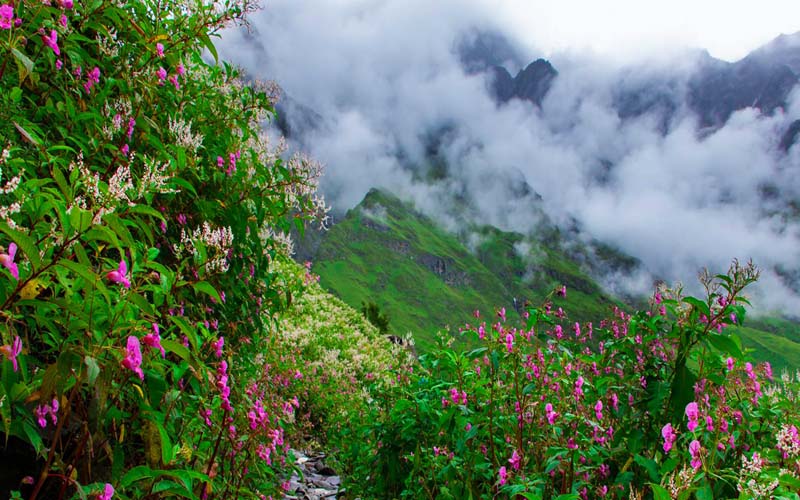
One Trek, a Thousand Wonders: Your Himalayan Journey Awaits
From blooming blue poppies and Brahma Kamal to elusive snow leopards and Himalayan monals, the Valley of Flowers trek is a living storybook written by nature, page after page. Every trail, every bloom, and every silent breath of the mountain air adds to the magic of this unforgettable destination.
But this isn't just a trek — it’s an experience of connection. With every step through the meadows, you’re not only witnessing nature’s beauty but also becoming part of its story.
Whether you're planning a soulful escape with your partner, a group trek with friends, or a solo journey into the wild, TourMyHoliday makes sure your adventure is smooth, safe, and soul-filling.
✅ Entry permits? Handled.
✅ Comfortable stays? Arranged.
✅ Local guides? Included.
✅ Lasting memories? Guaranteed.
So pack your spirit of adventure and let the Himalayas surprise you. Because the Valley of Flowers doesn’t just bloom — it transforms.
Book your Valley of Flowers tour now at: www.tourmyholiday.com
Tour with purpose. Trek with passion. Travel with TourMyHoliday
Frequently Asked Questions:
1. How can I reach the Valley of Flowers?
To reach the Valley of Flowers, you must first get to Govindghat (last motorable point), then trek 13 km to Ghangaria, followed by a 3 km trek into the valley.
2. What is the entry fee for Valley of Flowers in 2025?
Indian adults pay ₹200, senior citizens and differently-abled visitors pay ₹100, and foreign nationals pay ₹800. Children under 12 enter free. Students get discounts with a valid ID.
3. When is the best time to visit the Valley of Flowers?
The best time is mid-July to mid-August when the flowers are in full bloom just after the monsoon.
4. How long is the Valley of Flowers trek?
The trek includes 13 km from Govindghat to Ghangaria and an additional 3 km from Ghangaria to the Valley. It's usually completed in 2–3 days.
5. What kind of flowers can I see in the Valley of Flowers?
You can see over 600 species, including Blue Poppy, Brahma Kamal, Himalayan Orchid, Geranium, and Aconitum.
6. What wildlife can be spotted in the Valley of Flowers?
Wildlife includes snow leopards, Asiatic black bears, red foxes, musk deer, Himalayan monals, and blue sheep.
7. Are camera and video charges applicable?
Still photography for personal use is free. Commercial photography, videography, and drone use require special permits and extra charges.
8. Is the Valley of Flowers suitable for beginners?
Yes, it is a moderate and beginner-friendly trek. Tour My Holiday offers guided packages ideal for first-time trekkers.
9. Can couples book a private tour to the Valley of Flowers?
Yes, TourMyHoliday offers a Valley of Flowers tour package for couples, including comfortable stays and personalized experiences.
10. Where can I book a complete Valley of Flowers tour package?
You can book directly through Tour My Holiday at www.tourmyholiday.com, which offers fixed departures, guided treks, and permit arrangements.
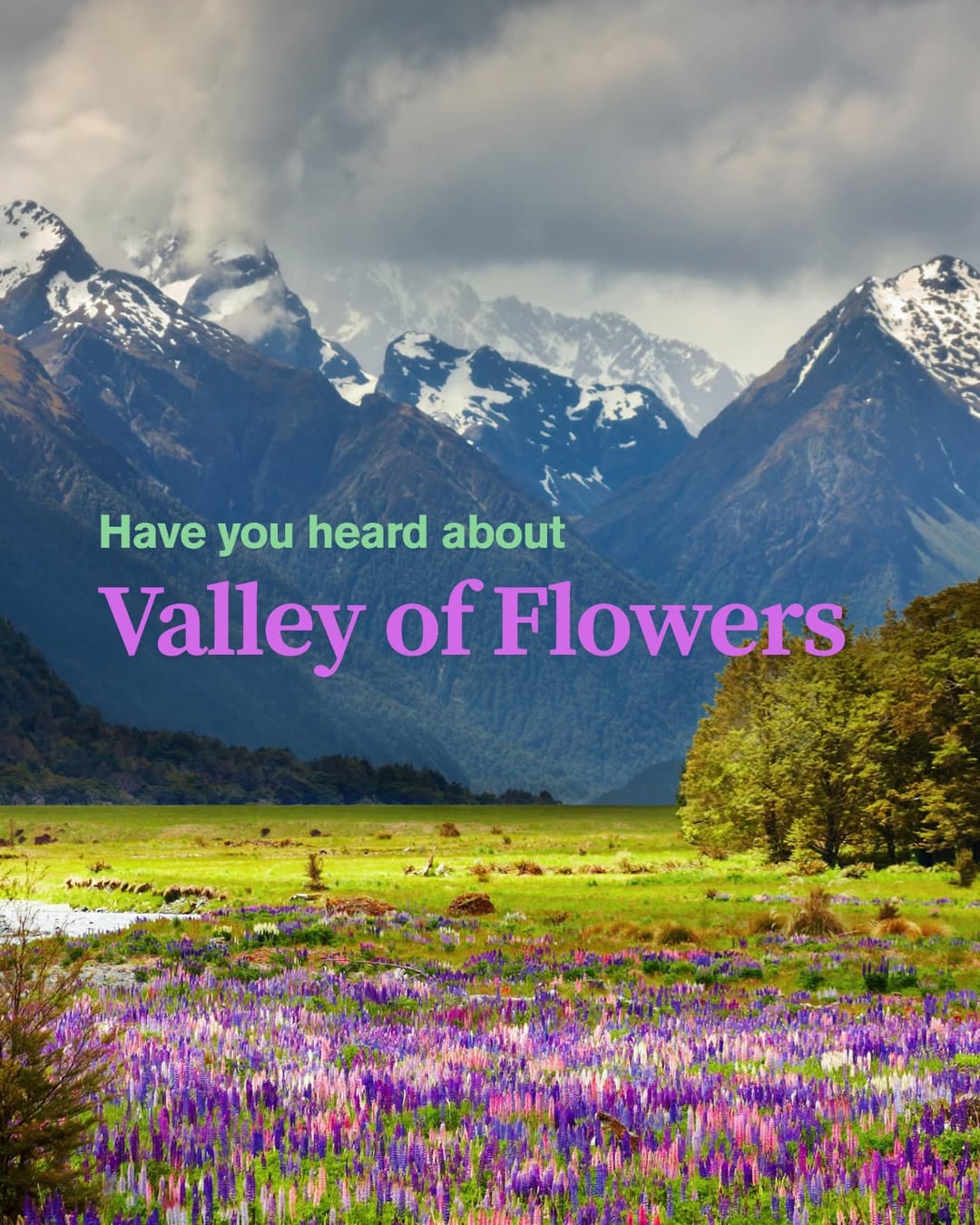

.jpg)
